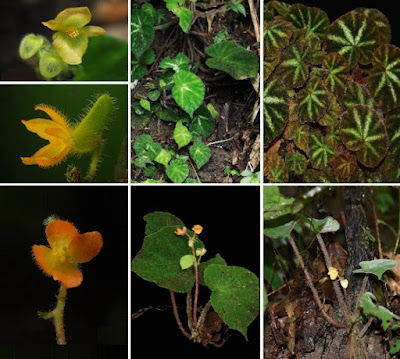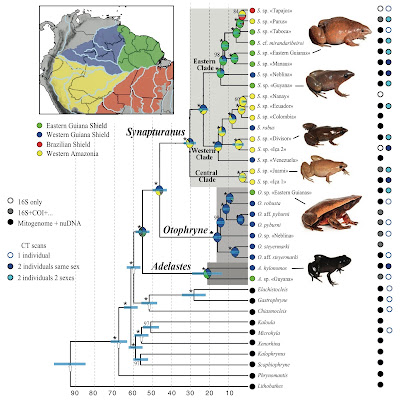[Most Recent Entries] [Calendar View]
Friday, February 19th, 2021
| Time | Event | ||
| 3:18a | [Botany • 2021] Thismia belumensis (Thismiaceae) • A Remarkable New Species from The Royal Belum State Park, Gerik, Perak, Peninsular Malaysia
Abstract This report describes Thismia belumensis Siti-Munirah & Suhaimi-Miloko, a novel species of achlorophyllous herb discovered in the Royal Belum State Park, Peninsular Malaysia. This new species is unlike any previously described species of Thismia. In particular, T. belumensis possesses a unique annulus, which has been expanded and modified into a cucullate (hood-like) structure. This structure covers the apical floral tube and has an opening on one side facing a thickened part of the annulus, and the off-centre floral aperture confers a zygomorphic symmetry to the flower, indicating T. belumensis is more similar to Thismia labiata J.J.Sm. This morphological detail makes this new species distinct from all other described species of Thismia. In this report, we provide descriptions, illustrations, colour plates, and the provisional conservation status of Thismia belumensis. Keywords: Conservation status, endemic, Peninsular Malaysia, Perak, Thismia belumensis, zygomorphic Thismia belumensis Siti-Munirah & Suhaimi-Miloko, sp. nov. Diagnosis: Most similar to Thismia labiata J.J.Sm. but differing in the floral tube partially covered by a massively expanded cucullate bilabiate annulus, longer outer tepals appendage, obovate to spathulate rather than linear to filiform inner tepals and the supraconnective apex curved outwards like a skirt rather than straight. Distribution: Endemic to Perak, Peninsular Malaysia. Currently known only from the type locality (Map 1). Ecology: Lowland dipterocarp forest, under shade, 260–290 m altitude. Flowering from June to October. Thismia belumensis was found growing within tree leaf litter and between the buttress roots of large trees (Fig. 4). Two other Thismia species were also discovered within a radius of about 350 meters, T. javanica and Thismia sp. 1 (see Fig. 5), which is currently suspected by the authors to be Thismia arachnites Ridl., but further examination is still needed. All plants were found close to the walking trail. Etymology: The species is named after The Royal Belum State Park, the type locality of this species. Mat Yunoh Siti-Munirah, Zainol Suhaimi-Miloko and Mohammad Ismail Zubir Ahmad. 2021. Thismia belumensis (Thismiaceae), A Remarkable New Species from The Royal Belum State Park, Gerik, Perak, Peninsular Malaysia. PhytoKeys. 172: 121-134. DOI: 10.3897/phytokeys.172.59336 Spesies baru untuk Malaysia | ||
| 7:24a | [Botany • 2019] Begonia zhongyangiana (Begoniaceae) • A New Species of Begonia from western China
Abstract Begonia zhongyangiana, a new species in Begonia sect. Platycentrum (Begoniaceae) from Motuo (SE Xizang, China), is described and illustrated. This new species is similar to B. versicolor, B. scintillans and B. smithiae, but can be distinguished by its shorter rhizome lacking or rarely with short stems when blooming, orange-yellow flowers, 2 styles and 2-loculed ovary. Keywords: Begonia, New taxon, Taxonomy, Tibet, western China, Eudicots Begonia zhongyangiana W.G.Wang et S.Z.Zhang, sp. nov . 鐘揚秋海棠 Etymology:—The specific epithet zhongyangiana is named after Dr. Yang Zhong, a Chinese botanist who was dedicated to botanical research and seed bank in Xizang (Tibet), China. Wen-Guang Wang, Xiao-An Lang, Lei-Lei Yang, Hong Wu and Shou-Zhou Zhang. 2019. Begonia zhongyangiana, A New Species of Begonia (Begoniaceae) from western China. Phytotaxa. 407(1); 51-58. DOI:10.11646/phytotaxa.407.1.8 | ||
| 8:55a | [Herpetology • 2021] Species Diversity and Biogeography of An Ancient Frog Clade from the Guiana Shield (Anura: Microhylidae: Adelastes, Otophryne, Synapturanus) exhibiting Spectacular Phenotypic Diversification
Abstract The outstanding biodiversity of the Guiana Shield has raised many questions about its origins and evolution. Frogs of the genera Adelastes, Otophryne and Synapturanus form an ancient lineage distributed mostly across this region. These genera display strikingly disparate morphologies and life-history traits. Notably, Synapturanus is conspicuously adapted to fossoriality and is the only genus within this group to have dispersed further into Amazonia. Moreover, morphological differences among Synapturanus species suggest different degrees of fossoriality that might be linked to their biogeographical history. Through integrative analysis of genetic, morphometric and acoustic data, we delimited 25 species in this clade, representing a fourfold increase. We found that the entire clade started to diversify ~55 Mya and Synapturanus ~30 Mya. Members of this genus probably dispersed three times out of the Guiana Shield both before and after the Pebas system, a wetland ecosystem occupying most of Western Amazonia during the Miocene. Using a three-dimensional osteological dataset, we characterized a high morphological disparity across the three genera. Within Synapturanus, we further characterized distinct phenotypes that emerged concomitantly with dispersals during the Miocene and possibly represent adaptations to different habitats, such as soils with different physical properties. Keywords: Amazonia, Amphibia, integrative taxonomy, micro-computed tomography, mitogenomics Antoine Fouquet, Killian Leblanc, Marlene Framit, Alexandre Réjaud, Miguel T Rodrigues, Santiago Castroviejo-Fisher, Pedro L V Peloso, Ivan Prates, Sophie Manzi, Uxue Suescun, Sabrina Baroni, Leandro J C L Moraes, Renato Recoder, Sergio Marques de Souza, Francisco Dal Vecchio, Agustín Camacho, José Mario Ghellere, Fernando J M Rojas-Runjaic, Giussepe Gagliardi-Urrutia, Vinícius Tadeu de Carvalho, Marcelo Gordo, Marcelo Menin, Philippe J R Kok, Tomas Hrbek, Fernanda P Werneck, Andrew J Crawford, Santiago R Ron, Jonh Jairo Mueses-Cisneros, Rommel Roberto Rojas Zamora, Dante Pavan, Pedro Ivo Simões, Raffael Ernst and Anne-Claire Fabre. 2021. Species Diversity and Biogeography of An Ancient Frog Clade from the Guiana Shield (Anura: Microhylidae: Adelastes, Otophryne, Synapturanus) exhibiting Spectacular Phenotypic Diversification. Biological Journal of the Linnean Society. 132(2); 233–256. DOI: 10.1093/biolinnean/blaa204 |
| << Previous Day |
2021/02/19 [Calendar] |
Next Day >> |













